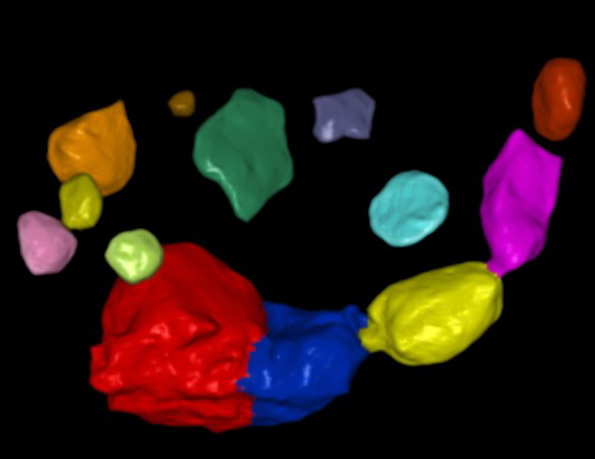3D/4D ultrasound
Ultrasound with infertility and PCOs
Generally
- Disorders of ovulation
- Polycystic ovary syndrome – PCOS
- Tubal infertility
- Problems with the uterus
- Age of the woman and quality of the eggs themselves
- Unexplained infertility
- Male infertility
The purpose of a Sono AVC ultrasound examination of the ovarian reserve is to determine the number of follicles in the ovaries and to identify women with an ovarian reserve (AFC <3-10) and women with polycystic ovaries. Thanks to this procedure we are able to identify women with a favourable prognosis and women with a reduced probability of spontaneous pregnancy.
| Number of antral follicles | Number of years to last possible pregnancy | Number of years to menopause |
|---|---|---|
| 20 | 14,8 | 24 |
| 12 | 9,3 | 18,4 |
| 10 | 4,2 | 12,9 |
| 5 | 0 | 7,3 |
Evaluation of ovulation is an important part of each examination in the scope of a menstruation cycle disorder. Even though regular menstruation cycles point to normal ovulation, this is not always the case.
Normal ovulation of a woman requires the interaction of several factors, such as correctly timing of levels of individual hormones up to the ovarian reserve itself. Often a small hormonal imbalance or disorder of ovulation can lead to “suboptimal fertility potential” i.e. subfertility.
- Inadequate ovulation
- Preliminary luteinized follicle
- Luteinized unruptured follicle (LUF syndrome)
- Insufficient luteal phase
- Lowered ovarian reserve
- Transvaginal pelvic ultrasound examination
- Measuring of basal body temperature (BBT)
- LH tests
- Biopsy of the endometrium
- Blood examinations of hormones (TSH, prolactin, total and free testosterone, DHEA, DHEAS, SHBG, AMH....)
- Vyšetrenia ovariálnej rezervy (AMH blood level, veľmi raritne každý cyklus na 3 deň FSH/ESTRA alebo clomid challenge test – CCCT)
When?
We determine the type of ovulation disorder and PCOS on the basis of wide hormonal profiles and ultrasound folliculometric measurement (AFC). Therefore, we plan the approach to each woman individually with regard to her menstruation cycle. We usually perform ultrasound examination focused on ovulation disorders (AFC) in 2 daily intervals from about the 9th day of the menstruation cycle from the first day of bleeding.
How?
The examination is performed by a vaginal ultrasound probe and lasts from 5 to 10 minutes. The numbers, absolute sizes and volumes of the follicles are subsequently evaluated very precisely using an expert software program. 3D ultrasound mapping is the most ideal tool for evaluation of the ovaries and their follicles in women with ovulation disorders and undergoing induction. For the most exact findings of the number of antral follicles we offer an expert 3D methodology determining their number and size: Sono AVC (Automatic Volume Calculation from GE Medical systems).
What is it for?
Previously, only conventional 2D ultrasound was used to determine the size of follicles, but this only gave the real volume of the follicles and an exact time of ovulation could only be estimated. The results of comparative studies have shown that using the new 3D method of Sono AVC in comparison with 2D ultrasound measurement significantly more eggs mature in the course of induction. The 3D ultrasound Sono AVC method is therefore much more objective, faster and reliable and displays the follicle metric reality much more precisely than common 2D ultrasound measurement. This leads to optimal adaptation of the entire process of stimulation and induction of ovulation in the sense of improved quality according to the aims of Directive 2004/23/EC of the European Parliament and of the Council of 31 March 2004).
The aim of stimulation and induction of ovulation is the production of a larger number of follicles in the ovaries, each of which contains an egg-oocyte and subsequently ensure its release, or “rupturing” of the dominant follicle. A month before the planned induction of ovulation, we can apply hormonal anticonception on a client as a gentle prevention of the creation of ovarian cysts. These cysts, which commonly occur in patients before the use of peroral anticonception, hold back the start of the cycle with an intervention into the normal hormonal function of the ovary.
For patients in whom before and during stimulation of ovulation we carry out 3D Sono AVC measurements, we demonstrably determine the following results:
- Higher number of qualitative follicles (criterial according to L. Veek)
- Higher success rate of impregnation with determined ovulation
- Significantly lower occurrence of ovarian hyperstimulation syndrome (OHSS)
With the help of correct management and treatments of certain ovulation disorders, adequate ovulation can be achieved in harmony with the menstruation cycle and subsequently possible pregnancy. It is especially important to point out the necessity of the ovarian reserve by a method of counting antral follicles in women with a diagnosis of polycystic ovaries (PCO).






